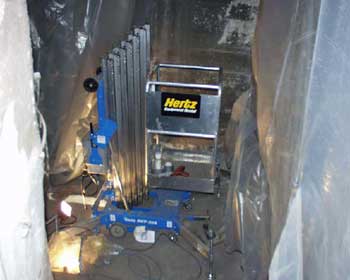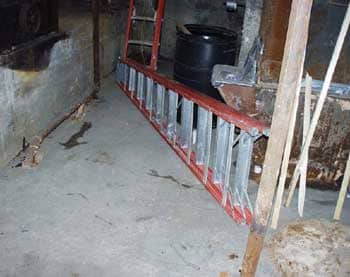Hispanic Asbestos Remover Falls to Death from Ladder
Nebraska Case Report: 06NE002
Report Release Date: May 3, 2006
Summary
A 43-year-old Hispanic male asbestos remover fell approximately 8 feet to his death after either he or the 10 foot step ladder he was standing on was struck by a piece of metal pipe. The victim was part of a four person crew preparing a boiler room for asbestos removal. Another worker hanging plastic sheeting from the ceiling above the victim was using a metal pipe that dropped approximately 22 feet, striking either the victim or the ladder he was using to string construction lights, causing the victim to fall to the concrete floor below. The victim was transported to a nearby local hospital where he was pronounced dead.
The Nebraska Workforce Development, Department of Labor’s Investigator concluded that to help prevent future similar occurrences, employers should:
- Ensure employees wear appropriate personal protective equipment (PPE) when required.
- Ensure that tools being used above other workers are secured to prevent them from falling and striking other workers.
- Retrain those employees that have not retained the requisite understanding and/or skills necessary to protect themselves and others during daily tasks.
Program Objective
The goal of the Fatality Assessment and Control Evaluation (FACE) workplace investigation is to prevent future work-related deaths or injuries, by a study of the working environment, the worker, the task the worker was performing, the tools the worker was using, and the role of management in controlling how these factors interact.
This report is generated and distributed solely for the purpose of providing current, relevant education to employers, their employees and the community on methods to prevent occupational fatalities and injuries.
Introduction
On February 1, 2006, at approximately 8:15 a.m., a 43-year-old Hispanic male asbestos removal laborer died after falling 8 feet from a step ladder onto a concrete floor. The Nebraska Department of Labor was notified of the fatality the same day by the Occupational Safety and Health Administration (OSHA). The Nebraska FACE Investigator met with the investigating OSHA Compliance Officer (CSHO) and company officials the same day at the mishap location. Another site visit was conducted with OSHA on February 3, 2006 to interview the Site Supervisor and General Contractor. Employee interviews were conducted with OSHA on February 15, 2006, with another CSHO acting as the interpreter.
The victim’s employer is an asbestoses removal company (SIC 9999). The company has been in business since 1989. At the time of the incident the company employed approximately 36 employees at multiple locations throughout the state. Of the 36 employees, approximately two thirds are Hispanic and most speak very little English.
The company provided copies of their Safety & Health manual, medical, training, and other records to the CSHO.
The employer had no previous history of fatalities prior to this incident.
Investigation
Victim: The victim (worker #1) was a 43-year-old Hispanic male. He had been employed by the company as an asbestos removal laborer since August 2004. He, along with the rest of the crew had been on this site for three and a half weeks. He had been employed by this company for approximately 1 ½ years.
Site supervisor: The site supervisor was also Hispanic and had worked for the company for 10 years. He spoke very little English.
Worker #3: Hispanic asbestos removal laborer, employed by the company for 3 months. He spoke no English.
Worker #4: Hispanic asbestos removal laborer, employed by the company for 3 ½ years. He spoke very little English.
Training: After hiring and prior to working, the victim, as with other asbestos removal personnel, are trained as required per State regulations. If training was not conducted in a language familiar to the employees, the company provided translators in the appropriate language. All required medical testing was accomplished, along with yearly medical follow-up testing. Copies of all training documentation and medical screening records were provided to the CSHO.
Analysis/Synopsis
The victim’s company was hired to remove asbestos from a multi-storied building most recently being utilized as a commercial laundry, but being converted into upscale condos.
The victim was part of a four-person asbestos removal crew. They had been on site approximately three and a half weeks. On the day of the mishap they were preparing a two-story boiler room for asbestos removal.
The victim was on the lower level, standing on a ten foot step ladder, stringing and installing temporary construction (drop) lighting with the assistance of worker #3. Worker #4 was on the second level changing filters on the HEPA vacuum system.
The site supervisor (worker #2) was attaching 6 mill plastic sheeting to 1”x 2”x 6’ long wooden boards also on the lower level. Once attached, he climbed into the Genie 30 foot single-person electric platform lift. While holding onto the plastic sheeting, he raised the lift to the ceiling, approximately 29 foot overhead. While holding the board against the ceiling with one hand worker #2 used a Remington powder-actuated ram set gun with the other hand to shoot a nail through the board into the concrete ceiling. Realizing the sheeting was too heavy to hold with one hand, he lowered the lift far enough to have worker #3 hand him a piece of metal pipe that was lying nearby. The pipe was 5’ 8” long, 3” in diameter and weighed between 12-15 pounds. He raised the lift back towards the ceiling, and then braced the pipe between the lift platform floor and the overhead board.
While holding the pipe with his left hand, he used the ram set gun to shoot the second nail into the board. Although the nail remained sticking out of the board by ¼ inch, he thought the board was secure and removed his left hand from the pipe.
As he did so, the pipe and board pulled away from the ceiling, causing them both to fall towards the ground. The board and sheeting remained attached to the ceiling by another board that was previously attached to the ceiling. The metal pipe fell out of the lift, falling approximately 14 feet, striking a 45 degree slanted roof that was directly underneath. The pipe then flew approximately 3 feet sideways, striking either the victim or the ladder he was standing on.
The victim fell 8 feet from the ladder to the concrete floor below. Worker #3 had his back to the victim. He stated he heard a noise, possibly from the pipe hitting the slanted roof. When he turned around he saw the victim lying on the concrete floor next to the ladder. He yelled at worker #2 in the lift, telling him the pipe had hit the victim and he was hurt. Worker #2 immediately lowered the lift and tried to render assistance to the victim. Worker #4 was not in direct line-of-sight of the accident and did not witness the fall.
Workers #3 & #4 tried to communicate with the victim, but he was unconscious. While they were removing the victim’s half-face respirator, worker #2 ran to the General Contractor’s office on the first floor to have him summon help. Local emergency personnel arrived within minutes. The victim regained consciousness for a brief period while being transported to a nearby medical facility, but died shortly thereafter.
Cause of Death
According to the death certificate, the cause of death was: Cerebral Edema
Note: The coroner stated that it could not be conclusively determined if the metal pipe used by worker #2 struck the victim, or if the victim struck some metal pipe hand rails when he fell.
Recommendations/Discussion
Recommendation #1: Ensure employees wear appropriate PPE when required.
Discussion: 1The employer is responsible for requiring the wearing of appropriate personal protective equipment in all operations where there is an exposure to hazardous conditions. The company safety manual lists the required PPE items and when they are to be utilized.
2Employees working in areas where there is a possible danger of head injury from impact, or from falling or flying objects, or from electrical shock and burns shall be protected by protective helmets. Protective helmets (hard hats) are provided to each employee. On the day of the accident none of the crew was wearing hard hats.
Recommendation #2: Ensure that tools being used above other workers are secured to prevent them from falling and striking other workers.
Discussion: Although not a regulatory requirement, every effort should be made to secure materials and/or equipment being utilized above other employees. The use of a simple lanyard equipped with snap hooks on both ends to attach to a tool and to the lift railing could prevent them from striking an employee below if dropped. If some form of “brace” is to be used again to support the overhead boards and sheeting, employers should consider drilling a hole through the pipe end and securing it to the basket, or using a tool that has less likelihood of rolling if loose. The toe board around the floor pan of the electric lift prevents materials that are placed there from falling off when not being used.
Recommendation #3: Retrain those employees that have not retained the requisite understanding and/or skills necessary to protect themselves and others during daily tasks.
Discussion: 3It is the responsibility of the employer to provide for frequent and regular inspections of the job site, materials, and equipment to be made by a competent person(s) designated by the employer.
4The employer shall instruct each employee in the recognition and avoidance of unsafe conditions and the regulations applicable to his or work environment to control or eliminate any hazards or other exposure to illness or injury. During the interviews each worker stated they knew of the PPE requirements for wearing hard hats yet none of the workers, including the supervisor, was wearing one. The workers and supervisor should be retrained so that the requisite proficiency is regained.
The victim’s employer visited the work site weekly and spoke with the site supervisor every two to three days. The General Contractor would normally conduct a daily walk around of the entire building, but once the plastic sheeting and asbestos removal signs were hung he did not go near that area.
References
- OSHA Part 1926 Code of Federal Regulations for Construction Standards, 1926.28.
- OSHA Part 1926 Code of Federal Regulations for Construction Standards, 1926.100.
- OSHA Part 1926 Code of Federal Regulations for Construction Standards, 1926.20(b)(2).
- OSHA Part 1926 Code of Federal Regulations for Construction Standards, 1926.21(b)(2).
Attachments

|
|
Attachment 1. Site diagram (Diagram not to scale) |
 |
|
Attachment 2. Genie 30’ Single Person Electric Platform Lift
being used on site. |
 |
|
Attachment 3. 10’ Step Ladder victim was standing on. |

|
|
Attachment 4. Plastic sheeting that fell during accident. |

|
|
Attachment 5. Metal pipe being used to brace boards/sheeting.
|
To contact Nebraska State FACE program personnel regarding State-based FACE reports, please use information listed on the Contact Sheet on the NIOSH FACE web site Please contact In-house FACE program personnel regarding In-house FACE reports and to gain assistance when State-FACE program personnel cannot be reached.
